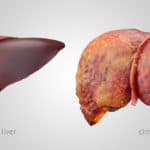Non-Invasive Testing for HCV Fibrosis Progression Improved
Biomarker Panel May Improve Disease Staging in Chronic HCV
By Michael Smith, North American Correspondent, MedPage Today
Published: March 05, 2008
Reviewed by Robert Jasmer, MD; Associate Clinical Professor of Medicine, University of California, San Francisco
www.medpagetoday.com
ANN ARBOR, Mich., March 5 — A panel of three biomarkers may be useful in identifying patients with chronic hepatitis C who have progressed to cirrhosis, researchers here found.
The three-marker panel was highly correlated to Ishak score in a prospective sub-study of the Hepatitis C Antiviral Long-term Treatment against Cirrhosis (HALT-C) Trial, according to Robert Fontana, M.D., of the University of Michigan, and colleagues.
The biomarkers were also more accurate than other non-invasive tests that have been proposed, the researchers reported in the March issue of Hepatology.
The three markers evaluated by the researchers were serum tissue inhibitor of matrix metalloproteinase-1 (TIMP-1), hyaluronic acid (HA), and platelet count.
All were significantly associated with cirrhosis in a univariate analysis (as were several other markers) but in multivariate analysis, the three biomarkers had an area under the receiver operating curve of 0.81.
(A receiver operating curve measures the trade-off between sensitivity and specificity for a given test; if the area under the curve were 1.0, the test would correctly identify both positives and negatives.)
By comparison, Dr. Fontana and colleagues said, three other published models — the Lok model, the AST-to-platelet ratio index, and the cirrhosis discriminant score — had lower areas under the curve of 0.79. 0.73, and 0.70 respectively.
For this study, the researchers compared the model’s predictions with the biopsy results of 513 patients with chronic hepatitis C and Ishak scores of between two and six. Those with Ishak scores of five and six (38%) were considered to have cirrhosis, while the remaining 62% had fibrosis.
Among those patients, the researchers found, the model would have correctly categorized 153 patients as having a low likelihood of cirrhosis with 86% accuracy.
An additional 146 subjects would have been categorized as having a high likelihood of cirrhosis with 73% accuracy.
The study was limited by the nature of the HALT-C patient population, the researchers said, which meant that there was no independent cohort of patients who also had stored serum available for testing for comparison.
Also, they noted, the model was not tested in an external validation cohort.
Nevertheless, the model “distinguished patients with non-cirrhotic (chronic hepatitis C) from those with cirrhosis” and “performed significantly better than other models based on routine laboratory tests,” the researchers concluded.
The implication is that serum fibrosis markers “provide useful, incremental information in estimating disease stage” in chronic hepatitis C that can be obtained without biopsy, they said.
The study was supported by the National Institute of Allergy and Infectious Diseases, the National Cancer Institute, the National Center for Minority Health and Health Disparities, the National Center for Research Resources of the NIH, and Hoffmann-La Roche Inc.
Dr. Fontana reported being on the speakers bureau for Hoffmann-La Roche.







